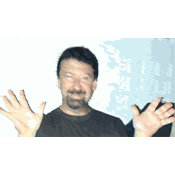œuvre 2
Counter-Googling,
by CATHBLEUE (France), 2004
INFORMATION AS A FINE ART
 On October 30, 1938, Orson Welles and his theatre company The Mercury Theater, in their eponymous radio show The Mercury Theatre On the Air, presented War of the Worlds, based on H.G. Wells' novel. During the time of the broadcast - barely an hour - listeners came to believe that Martians had invaded the U.S. For a few hours, panic and mayhem spread through the country, with dozens of accidents, and even, it was said, a few cases of suicide. If the production remains so well known, a special case in fact, it's because it steered a narrow yet strategic course between information (or news) and fiction.
On October 30, 1938, Orson Welles and his theatre company The Mercury Theater, in their eponymous radio show The Mercury Theatre On the Air, presented War of the Worlds, based on H.G. Wells' novel. During the time of the broadcast - barely an hour - listeners came to believe that Martians had invaded the U.S. For a few hours, panic and mayhem spread through the country, with dozens of accidents, and even, it was said, a few cases of suicide. If the production remains so well known, a special case in fact, it's because it steered a narrow yet strategic course between information (or news) and fiction.
Fiction, to recall Aristotle, presents itself as an imitation of reality1 - but an imitation that develops openly, following a code accepted by all parties. Information borrows its narrative structures from fiction, but is legitimized as information by operating within a framework that postulates a necessary return to the real. Information and fiction are not incompatible, nor as distinct as night and day. They are both creations of language; yet they are separated by several codes, the most important being... the Law.
In the case of Welles' radio performance, the scandal arose from smudging the border-line between fiction and information - not because The Mercury Theater On the Air had organized a hoax, but because, in its implementation, this fiction had used the operational codes of information.
Today such performances are impossible, as they would be subject to legal action.
Yet there are artists who explore the narrow strait between fiction and information.
They are the representatives of Google Art.
Their premise, and the reason why they can be grouped under the term "Google Art," is this: the renowned search engine having quickly achieved the position it has, we owe it to ourselves to use its information-processing capabilities for our own purposes, to turn the search and indexing engine into a fiction engine.
We owe it to ourselves to use the means of information for the purposes of fiction.
That is what Christophe Bruno did, for instance, with Google's Adwords program, which allows the search engine to turn sponsored links into a gold mine.
Not that he got very far with the project, as Google prohibited him from continuing a practice that was subverting the system.
Valéry Grancher turned Google into an engine for producing artistic propositions, called search art.
Other artists managed to transcribe information into visual form: Marika Dermineur, in Google House, and Gérard Dalmon, in his Google Body.
With Counter-Googling, Cathbleue's2 intention isn't to thwart Google's operation, but to precede it.
Counter-Googling as a practice does in fact exist3, and is none other than a search for targeted information; participants at counter-googling.net simply prepare their portrait in advance, as if one had already launched a search on their name.
In doing so, they are subverting the search engine principle, since, as anyone can see, the first results to show up when searching on any of the Counter-Googling artists will be the portrait that Cathbleue and each of the participants have concocted!
The mirror effect thus obtained certainly contradicts the information principle, which postulates a relationship based on facts - When? Where? How? - that have occurred or are occurring. One could almost speak of deceit if Counter-Googling participants' intentions were dishonest.
The fictional work jointly undertaken by Cathbleue and the "googlized" - among them not only well-known personalities, like dancer Sylvie Guillem, Tokyo Palace co-director Nicolas Bourriaud, and visual artist Patrick-Henry Burgaud, but also Bruce Lee fans, New York cab drivers, budding artists, etc. - resides in a new appropriation of media by everyone, a post-modern ironical twist in which, the codes being known and familiar to all, anyone can pull the strings of his own puppet. In an anonymous participant's Google-portrait of "Nobody," one can see the ultimate stage in the process of blurring fiction with information. Nobody is indeed quite a popular character on the Net - Google gives 26,200,000 occurrences. But who is Nobody? Perhaps the blind spot between between fiction and information.
The hitch in Cathbleue's work may well lie in this "Nobody," which seems to stretch the logic to its limits, but ultimately settles into sterile quandaries and endless loops. Information, in still other works, notably works of cartography, is certainly subject to appropriation by artists - and rightly so, since information itself readily steels from art -, but artists must also give meaning to their work, something that goes beyond the well-worn paradigm of the snake-biting-its-own-tail.
In the end, the self-portraits given at counter-googling.net are the best answer yet to the hazardous course between fiction and information.
Sometimes ironic, sometimes graphically ingenious, sometimes a bottle tossed out to sea - at a time when information reigns supreme, these shared self-portraits give a nuanced overview of an era, a practice, and an art.

Notes
1 : Aristote, Poetics, Chapter 1, paragraph 2. 
2 : Catherine Ramus's alias - see also the website www.cathbleue.com. 
3 : See Alain Steinmann's article, entitled « L'art du counter-googling » : « Demain, le counter-googling sera un réflexe, un prérequis avant toute relation humaine. », in 01net., 25/09/2003. 
Xavier Malbreil
(Translated from French by Ron Ross)

 top top
 back back
|
